Research on Coaxiality Measurement Method for Automobile Brake Piston Components Based on Machine Vision
Abstract
1. Introduction
2. Detection Methods
2.1. Image Preprocessing
2.2. Extract the Region of Interest
2.3. Extracting Geometric Feature Points of the Cylinder
- (1)
- Extract the y-elements from the two-dimensional array and store them in a new one-dimensional array. Find the largest element in this one-dimensional array. This maximum element corresponds to the y coordinate of and is denoted as .
- (2)
- Extract all elements from the two-dimensional array where , and store them in a new two-dimensional array . Extract the first element from . This element represents the coordinate value of the extremum point , denoted as , as shown in Figure 7.
- (3)
- Extract the y-elements from the two-dimensional array and store them in a new one-dimensional array. Find the minimum element in this one-dimensional array. This minimum element corresponds to the y coordinate of and is denoted as .
- (4)
- Extract all elements from the two-dimensional array where , and store them in a new two-dimensional array . Extract the first element from . This element represents the coordinate value of the extremum point , denoted as , as shown in Figure 7.
2.4. Edge Optimization
- (1)
- As shown in Figure 8b, the image after removing the lower edge pixel points of the spring is set to Ts(x,y) and the width is X3. The spring edge pixel points of each column in the image Ts(x,y) are extracted successively, and X3 two-dimensional arrays E(x,y) are obtained.
- (2)
- The first element in the two-dimensional array E(x,y) is extracted and stored in a new two-dimensional array E1(x,y), and X3 pixels on the upper edge of the spring are obtained. The optimized results are shown in Figure 10.
2.5. Extracting Geometric Feature Points of the Spring
- (1)
- Given a neighborhood interval centered around a pixel point, the neighborhood radius includes pixel points.
- (2)
- Start from the leftmost pixel point of the image and go through all the pixel points in the image in turn.
- (3)
- If the y-value of the pixel point is less than or equal to the y-values of the pixel points within the neighborhood, that pixel point is a extremum point, and stored in a new two-dimensional array. This process results in four new two-dimensional arrays.
- (1)
- To further refine step 2, as mentioned earlier, there may be a situation where wave peak extremum points are extracted, as shown in Figure 12e. To avoid the impact of this situation on the results, the method in this paper involves setting a straight line before extracting wave trough extremum points and removing all pixel points where . The resulting image after this step is denoted as step 1 in Figure 13.
- (2)
- For the four two-dimensional arrays obtained from step 3 as described above, let them be denoted as T1(x,y), T2(x,y), T3(x,y) and T4(x,y).
- (3)
- It can be seen that the two-dimensional array T4(x,y) does not contain spring geometric feature points, and the y value in T4(x,y) is the minimum value. According to this condition, the two-dimensional array T4(x,y) can be deleted.
- (4)
- Extract the first element from T1(x,y), T2(x,y), and T3(x,y), which are the coordinates of the three extreme points t1, t2, t3, denoted as .
2.6. Calculate the Equation of the Measured Axis
- (1)
- Given three straight lines in the vertical direction, the three straight lines pass the extreme points t1, t2 and t3 on the upper edge of the spring, respectively. Because the three extreme value point coordinate values are t1(x3, Δ3), t2(x4, Δ4), and t3(x5, Δ5), the equation of three lines is L10: x = x3, L11: x = x4, and L12: x = x5, respectively.
- (2)
- The three points where the three straight lines intersect the tangent line L8 of the lower edge of the spring are set as o1, o2, and o3, respectively. Because the equation of line L8 is y = K3·x + M3, the coordinates of the three intersection points are o1 (x3, K3·x3 + M3), o2 (x4, K3·x4 + M3), and o3 (x5, K3·x5 + M3), respectively.
- (3)
- The coordinates of s1, s2, and s3 can be determined as s1(x3, [(Δ3 + K3·x3 + M3)/2]), s2(x4, [(Δ4 + K3·x4 + M3)/2]), and s3(x5, [(Δ5 + K3·x5 + M3)/2]), respectively.
- (4)
- The coordinates of s1, s2 and s3 are set as s1(U10 = x3, V10 = [(Δ3 + K3·x3 + M3)/2]), s2(U11 = x4, V11 = [(Δ4 + K3·x4 + M3)/2]), and s3(U12 = x5, V12 = [(Δ5 + K3·x5 + M3)/2]), respectively.
- (5)
- The equation of the measured axis L9 can be fitted from Equation (7), and the slope of the measured axis L9 is denoted as K4. The angle θ between the measured axis L9 and the reference axis L6 can be calculated using Equation (8).
3. Experimental Verification
3.1. Detection System
3.2. Experimental Results
3.3. Discussion and Analysis
4. Conclusions
- Analyzing the structural characteristics of automotive brake piston components and extracting the regions of interest based on these characteristics.
- Proposing a mathematical morphology-based edge optimization method for complex edge structures, which removes redundant pixel points and optimizes image data into an n × n matrix (where n is the width of the image), thereby improving the accuracy of geometric feature point extraction.
- Determining the positions of extreme points by comparing the height of pixel points with that of neighboring pixel points, thus successfully extracting the coordinates of geometric feature points.
Author Contributions
Funding
Institutional Review Board Statement
Informed Consent Statement
Data Availability Statement
Acknowledgments
Conflicts of Interest
References
- Xiao, Y.; Luo, Y.; Xin, Y.P.; Wang, X.D. Part Coaxiality Detection Based on Polynomial Interpolation Subpixel Edge Detection Algorithm. In Proceedings of the 3rd World Conference on Mechanical Engineering and Intelligent Manufacturing (WCMEIM), Shanghai, China, 4–6 December 2020; pp. 377–380. [Google Scholar]
- Liu, Y.M.; Wang, D.W.; Li, Z.K.; Bai, Y.; Sun, C.Z.; Tan, J.B. A coaxiality measurement method by using three capacitive sensors. Precis. Eng.-J. Int. Soc. Precis. Eng. Nanotechnol. 2019, 55, 127–136. [Google Scholar] [CrossRef]
- Dou, Y.P.; Zheng, S.; Ren, H.R.; Gu, X.H.; Sui, W.T. Research on the measurement method of crankshaft coaxiality error based on three-dimensional point cloud. Meas. Sci. Technol. 2024, 35, 035202. [Google Scholar] [CrossRef]
- Chai, Z.; Lu, Y.H.; Li, X.Y.; Cai, G.; Tan, J.; Ye, Z.B. Non-contact measurement method of coaxiality for the compound gear shaft composed of bevel gear and spline. Measurement 2021, 168, 108453. [Google Scholar] [CrossRef]
- Wang, L.; Yang, T.Y.; Wang, Z.; Ji, Y.C.; Liu, C.J.; Fu, L.H. Simple measuring rod method for the coaxiality of serial holes. Rev. Sci. Instrum. 2017, 88, 113110. [Google Scholar] [CrossRef]
- Zhang, Y.G.; Wang, Y.D.; Liu, Y.J.; Lv, D.P.; Fu, X.B.; Zhang, Y.C.; Li, J.M. A concentricity measurement method for large forgings based on laser ranging principle. Measurement 2019, 147, 106838. [Google Scholar] [CrossRef]
- Gao, C.; Lu, Y.H.; Lu, Z.W.; Liu, X.Y.; Zhang, J.H. Research on coaxiality measurement system of large-span small-hole system based on laser collimation. Measurement 2022, 191, 110765. [Google Scholar] [CrossRef]
- Li, C.F.; Xu, X.P.; Sun, H.Q.; Miao, J.W.; Ren, Z. Coaxiality of Stepped Shaft Measurement Using the Structured Light Vision. Math. Probl. Eng. 2021, 2021, 5575152. [Google Scholar] [CrossRef]
- Zheng, Y.S.; Lou, Z.F.; Li, Y.; Wang, X.D.; Wang, Y. A Measuring Method of Coaxiality Errors for Apart Axis. In Proceedings of the 10th International Symposium on Precision Engineering Measurements and Instrumentation (ISPEMI), Kunming, China, 8–10 August 2018. [Google Scholar]
- Berry, M.V.; Lewis, Z.; Nye, J.F.J.P.o.t.R.S.o.L.A.M.; Sciences, P. On the Weierstrass-Mandelbrot fractal function. Proc. R. Soc. Lond. A Math. Phys. Sci. 1980, 370, 459–484. [Google Scholar]
- Guariglia, E. Harmonic Sierpinski Gasket and Applications. Entropy 2018, 20, 714. [Google Scholar] [CrossRef] [PubMed]
- Guariglia, E.; Guido, R.C. Chebyshev Wavelet Analysis. J. Funct. Spaces 2022, 2022, 5542054. [Google Scholar] [CrossRef]
- Guariglia, E.; Silvestrov, S. Fractional-Wavelet Analysis of Positive definite Distributions and Wavelets on D’(C). In Engineering Mathematics Ii: Algebraic, Stochastic and Analysis Structures for Networks, Data Classification and Optimization; Silvestrov, S., Rancic, M., Eds.; Springer Proceedings in Mathematics & Statistics; Springer: Berlin/Heidelberg, Germany, 2016; Volume 179, pp. 337–353. [Google Scholar]
- Guido, R.C.; Pedroso, F.; Contreras, R.C.; Rodrigues, L.C.; Guariglia, E.; Neto, J.S. Introducing the Discrete Path Transform (DPT) and its applications in signal analysis, artefact removal, and spoken word recognition. Digit. Signal Process. 2021, 117, 103158. [Google Scholar] [CrossRef]
- Yang, L.; Su, H.L.; Zhong, C.; Meng, Z.Q.; Luo, H.W.; Li, X.C.; Tang, Y.Y.; Lu, Y. Hyperspectral image classification using wavelet transform-based smooth ordering. Int. J. Wavelets Multiresolution Inf. Process. 2019, 17, 1950050. [Google Scholar] [CrossRef]
- Zheng, X.W.; Tang, Y.Y.; Zhou, J.T. A Framework of Adaptive Multiscale Wavelet Decomposition for Signals on Undirected Graphs. IEEE Trans. Signal Process. 2019, 67, 1696–1711. [Google Scholar] [CrossRef]
- Tan, Q.C.; Kou, Y.; Miao, J.W.; Liu, S.Y.; Chai, B.S. A Model of Diameter Measurement Based on the Machine Vision. Symmetry 2021, 13, 187. [Google Scholar] [CrossRef]
- Wu, X.F.; Wang, C.S.; Tian, Z.Z.; Huang, X.K.; Wang, Q. Research on Belt Deviation Fault Detection Technology of Belt Conveyors Based on Machine Vision. Machines 2023, 11, 1039. [Google Scholar] [CrossRef]
- Xiao, G.F.; Li, Y.T.; Xia, Q.X.; Cheng, X.Q.; Chen, W.P. Research on the on-line dimensional accuracy measurement method of conical spun workpieces based on machine vision technology. Measurement 2019, 148, 106881. [Google Scholar] [CrossRef]
- Ye, J.W.; Zhao, L.H.; Liu, S.; Wu, P.W.; Cai, J.T. Design and Experimentation of a Residual-Input Tube-End Cutting System for Plasma Bags Based on Machine Vision. Appl. Sci. 2023, 13, 5792. [Google Scholar] [CrossRef]
- Zhang, N.; Li, F.; Zhang, E.X. The Machine Vision Dial Automatic Drawing System-Based on CAXA Secondary Development. Appl. Sci. 2023, 13, 7365. [Google Scholar] [CrossRef]
- Li, B. Research on geometric dimension measurement system of shaft parts based on machine vision. Eurasip J. Image Video Process. 2018, 2018, 101. [Google Scholar] [CrossRef]
- Zhang, W.; Han, Z.W.; Li, Y.; Zheng, H.Y.; Cheng, X. A Method for Measurement of Workpiece form Deviations Based on Machine Vision. Machines 2022, 10, 718. [Google Scholar] [CrossRef]
- Wei, G.; Tan, Q.C. Measurement of shaft diameters by machine vision. Appl. Opt. 2011, 50, 3246–3253. [Google Scholar] [CrossRef] [PubMed]
- Sun, Q.C.; Hou, Y.Q.; Tan, Q.C.; Li, C.J. Shaft diameter measurement using a digital image. Opt. Lasers Eng. 2014, 55, 183–188. [Google Scholar] [CrossRef]
- Zhang, L.G.; Yang, Q.L.; Sun, Q.; Feng, D.Y.; Zhao, Y. Research on the size of mechanical parts based on image recognition. J. Vis. Commun. Image Represent. 2019, 59, 425–432. [Google Scholar] [CrossRef]
- Bos, L.; Sommariva, A.; Vianello, M. Least-squares polynomial approximation on weakly admissible meshes: Disk and triangle. J. Comput. Appl. Math. 2010, 235, 660–668. [Google Scholar] [CrossRef]
- Liang, W.K.; Chapman, C.T.; Frisch, M.J.; Li, X.S. Geometry Optimization with Multilayer Methods Using Least-Squares Minimization. J. Chem. Theory Comput. 2010, 6, 3352–3357. [Google Scholar] [CrossRef]
- Markovsky, I.; Kukush, A.; Van Huffel, S. Consistent least squares fitting of ellipsoids. Numer. Math. 2004, 98, 177–194. [Google Scholar] [CrossRef]
- Mortari, D. Least-Squares Solution of Linear Differential Equations. Mathematics 2017, 5, 48. [Google Scholar] [CrossRef]
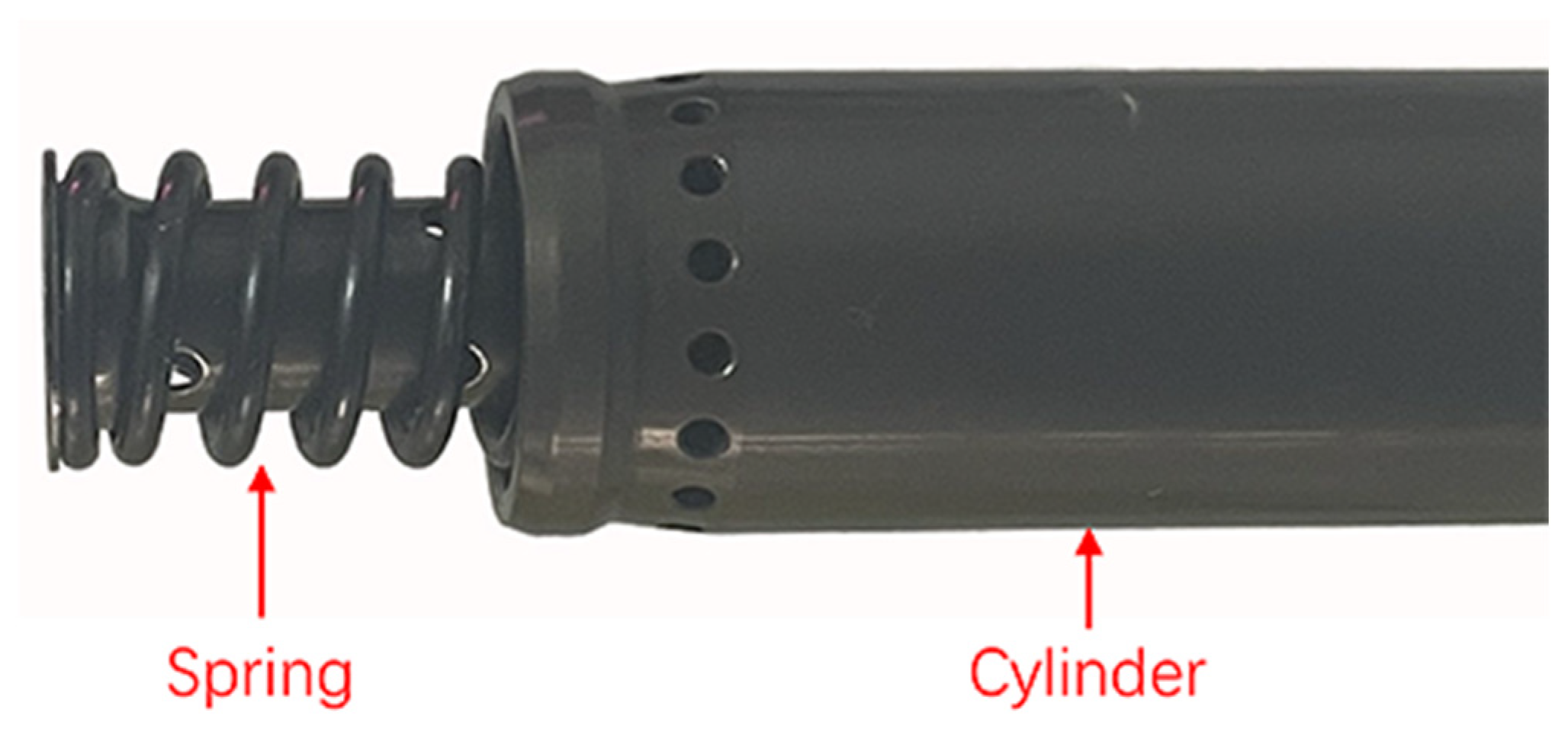
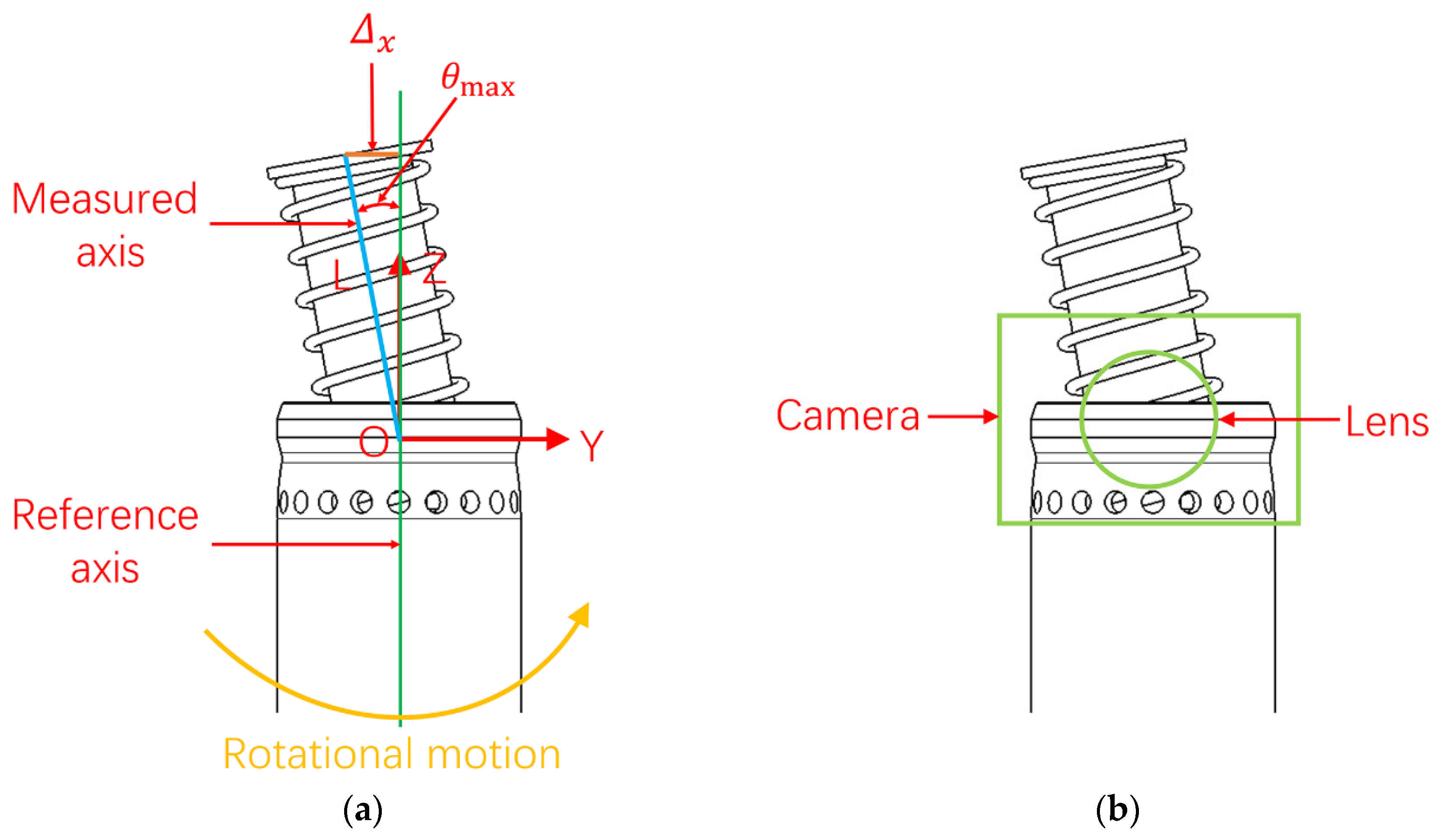
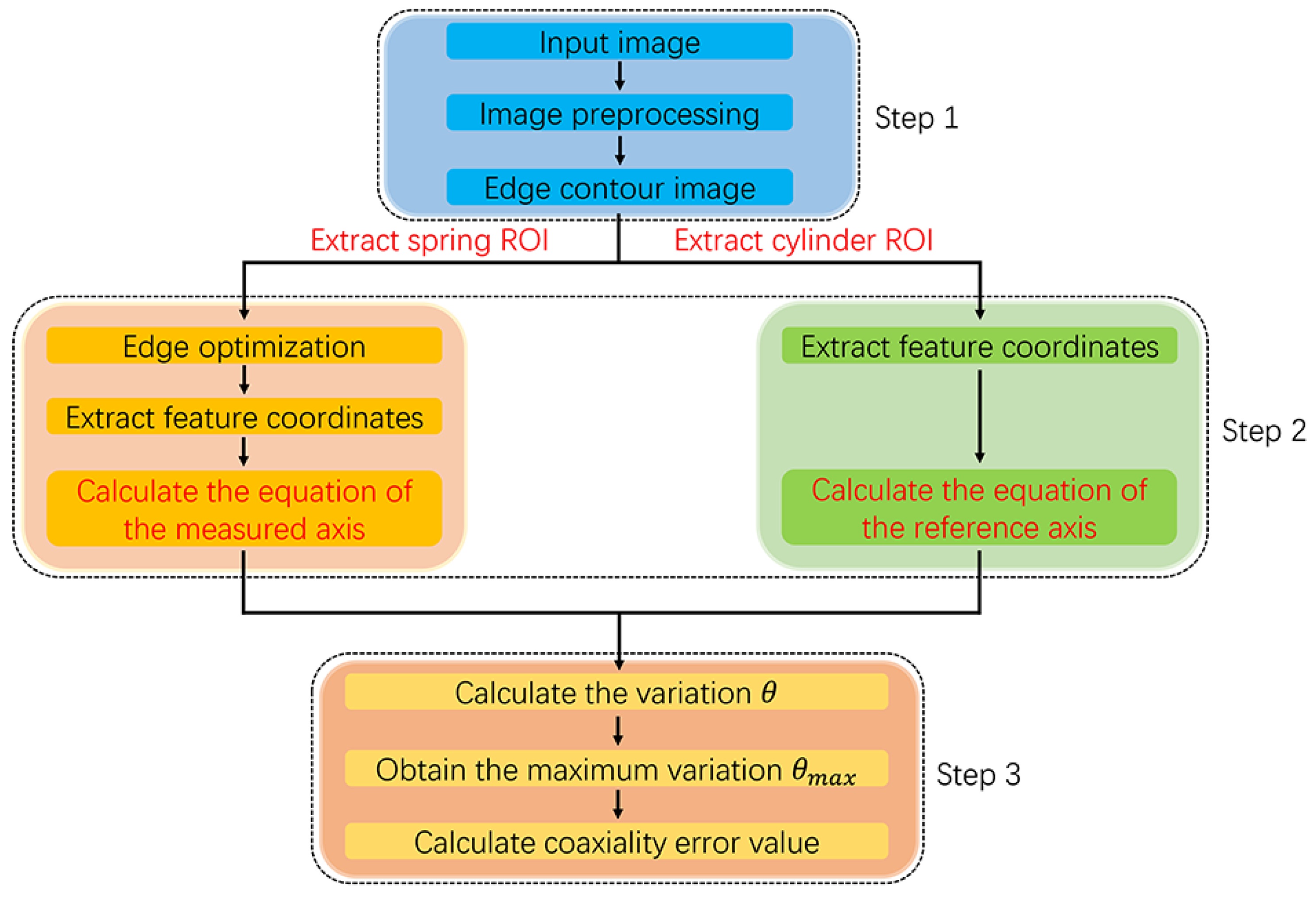
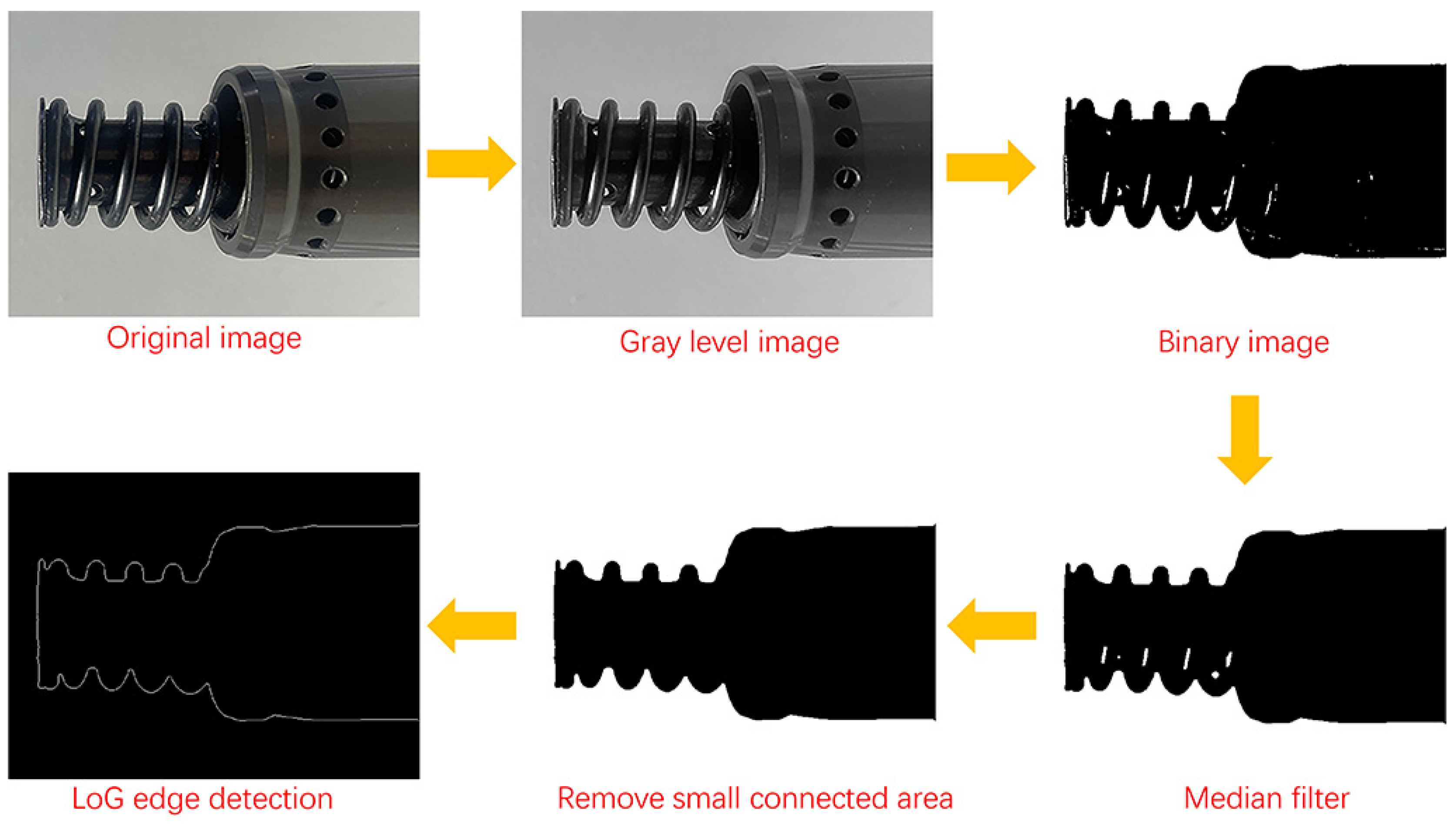
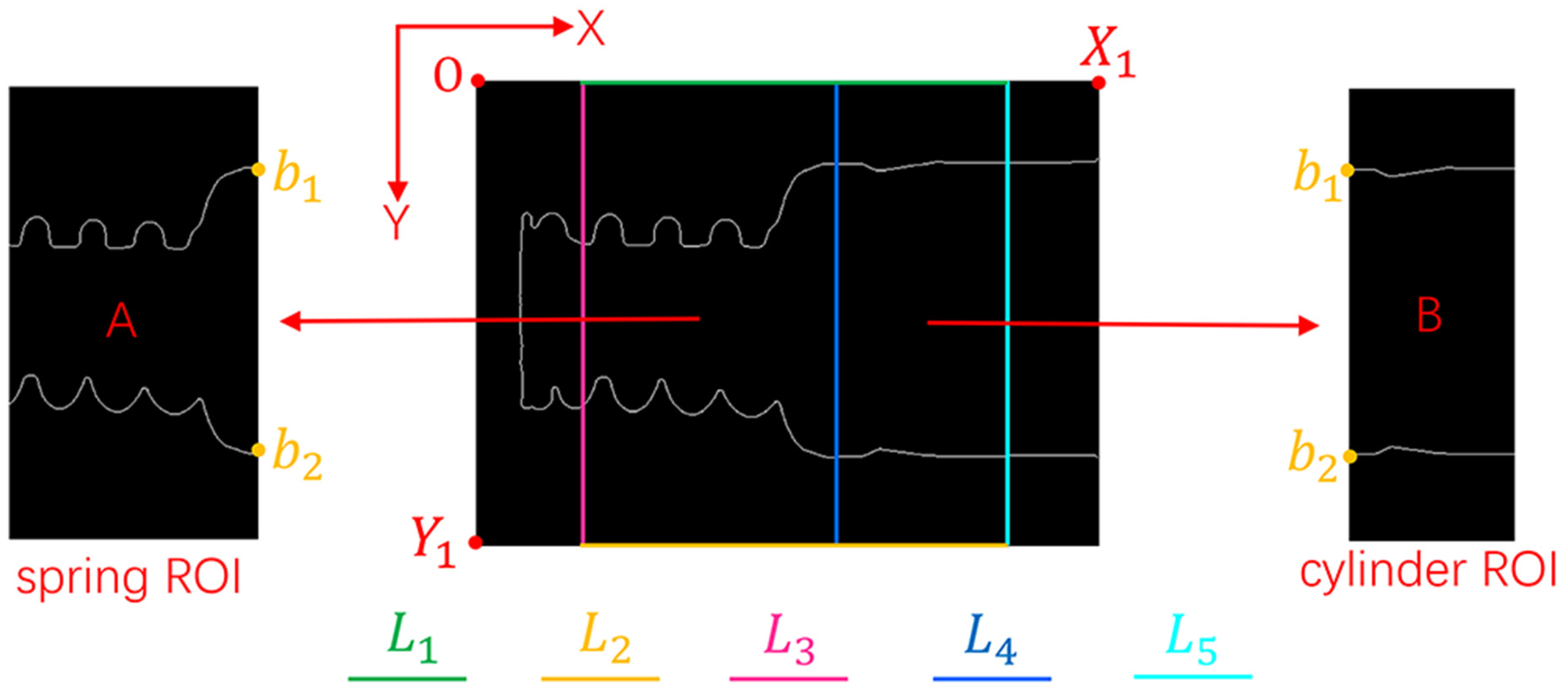
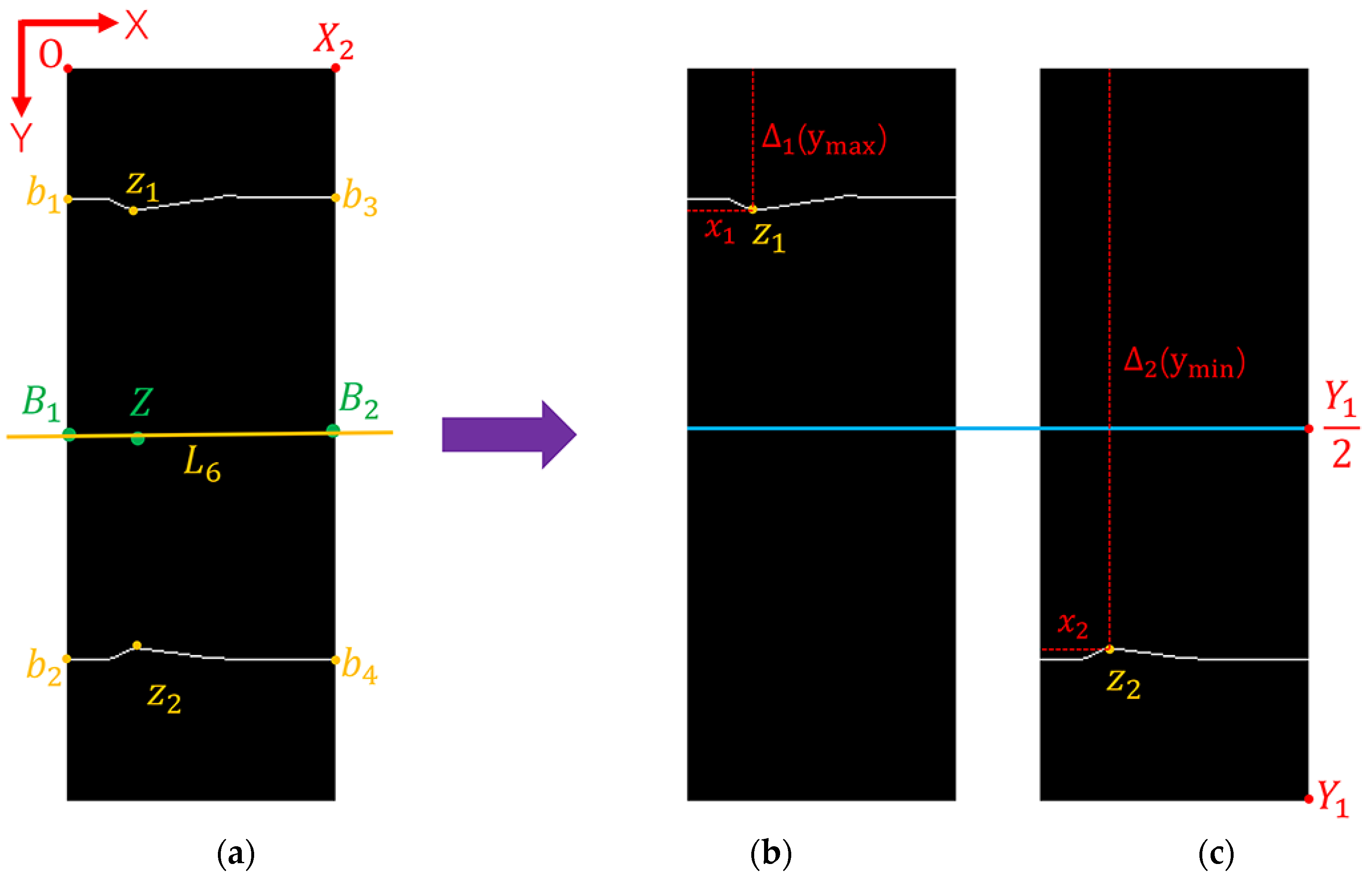
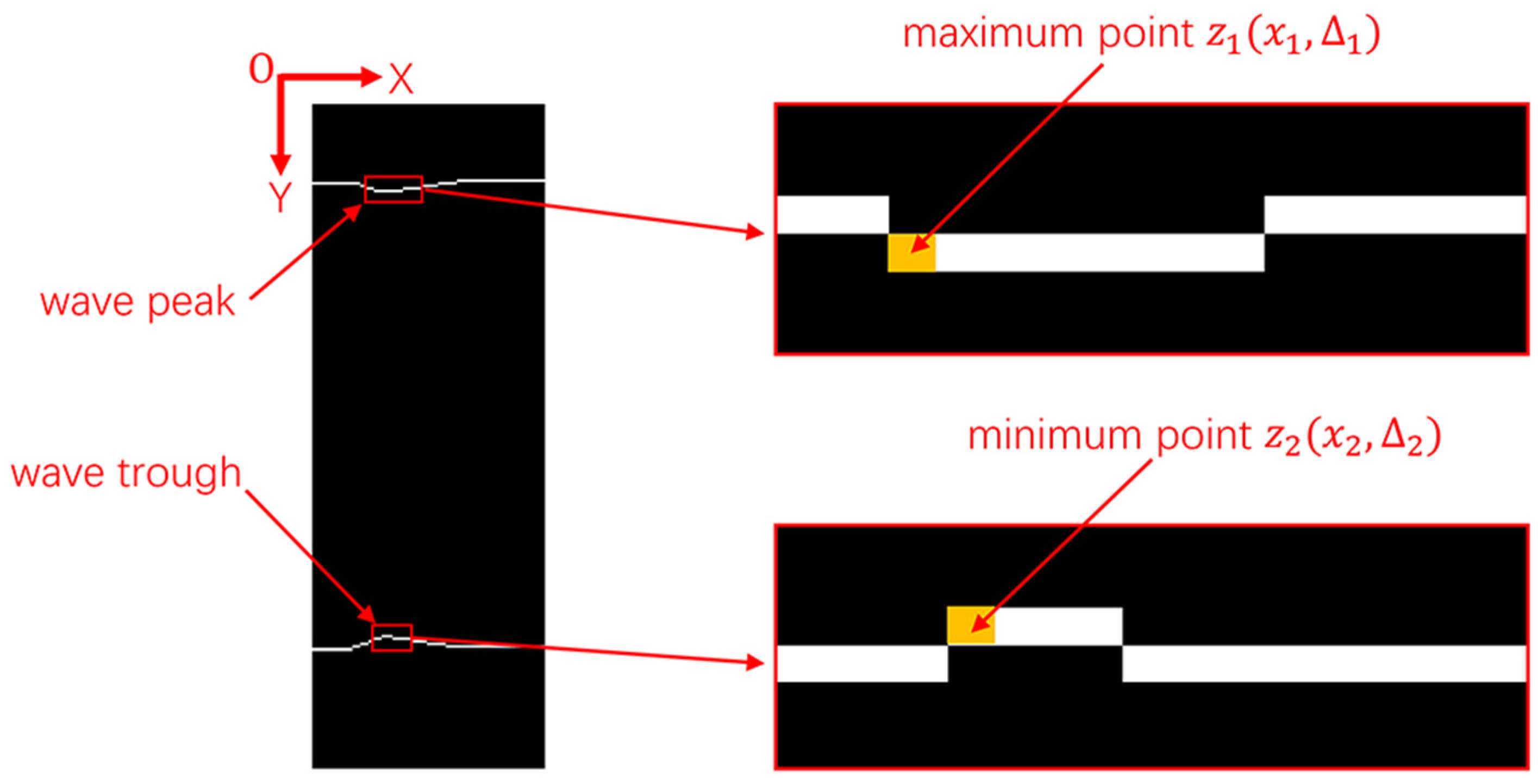

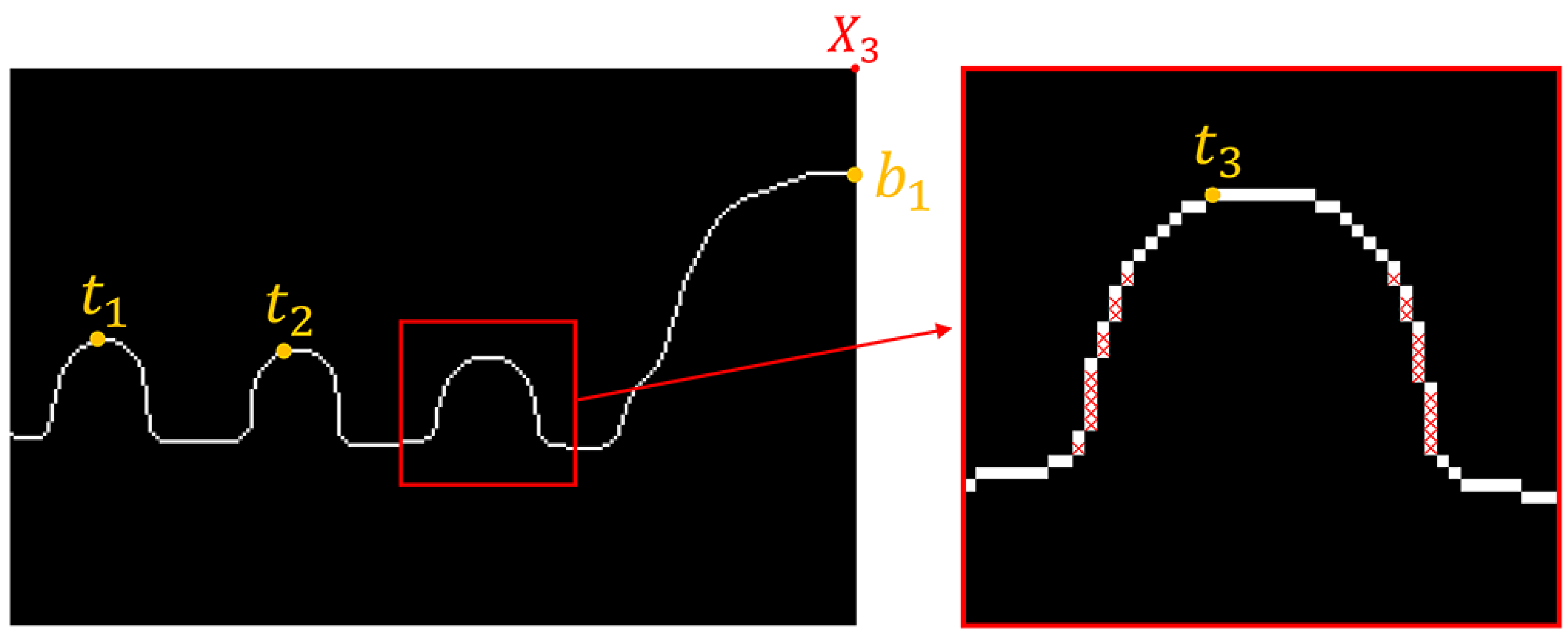
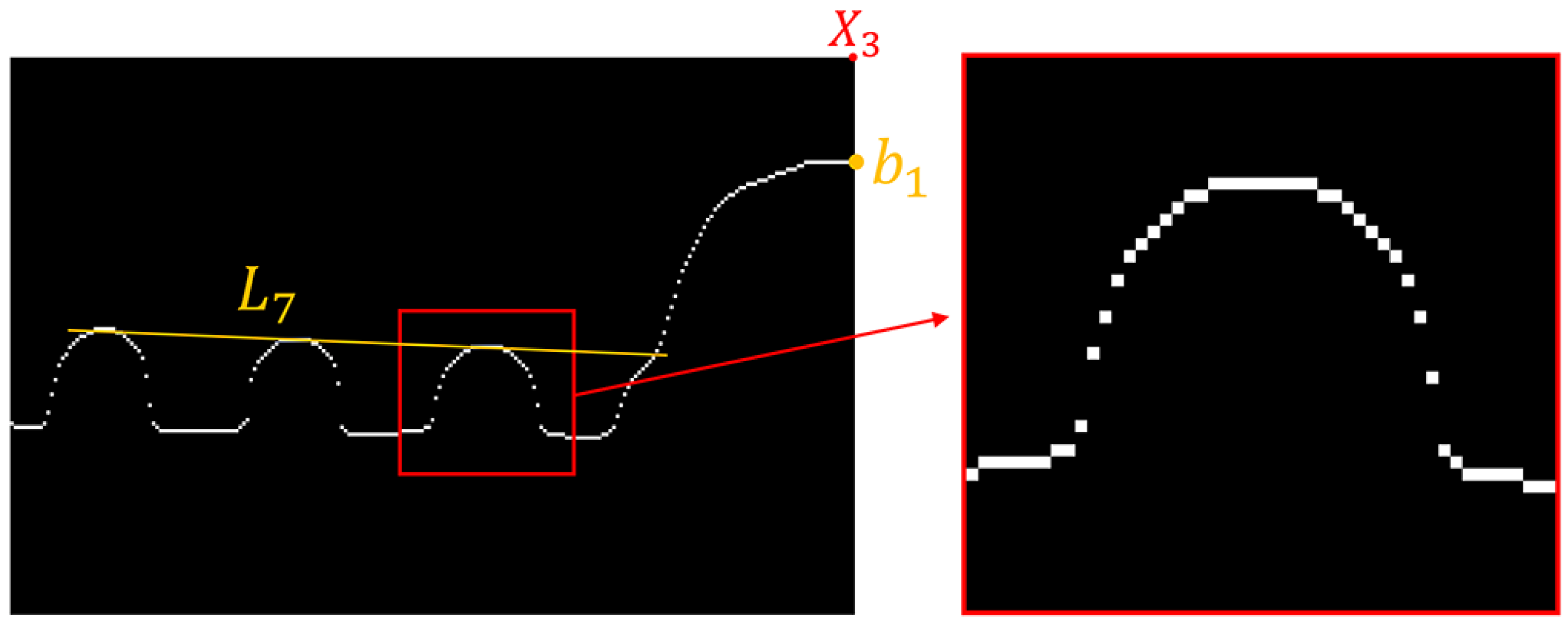
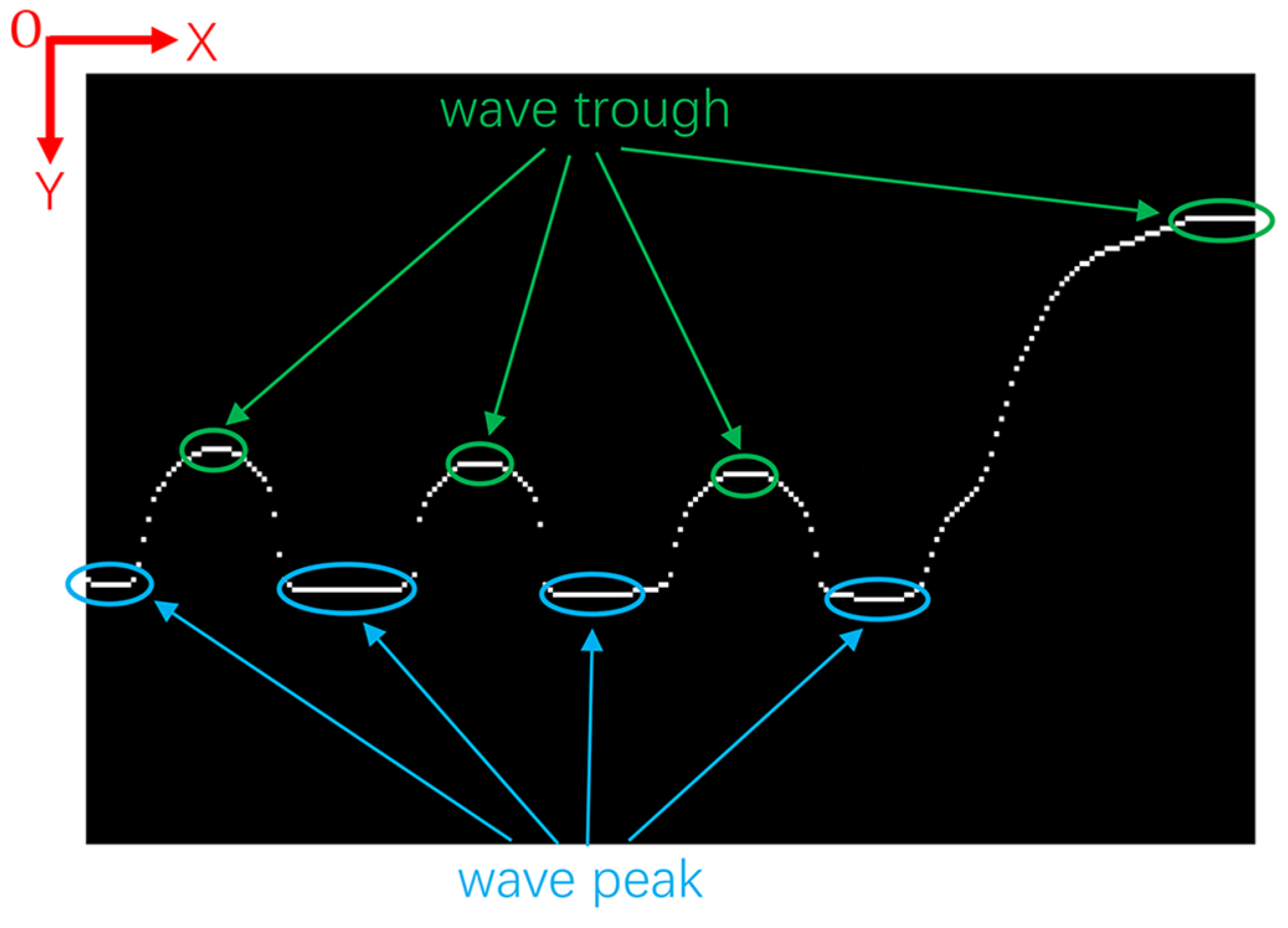

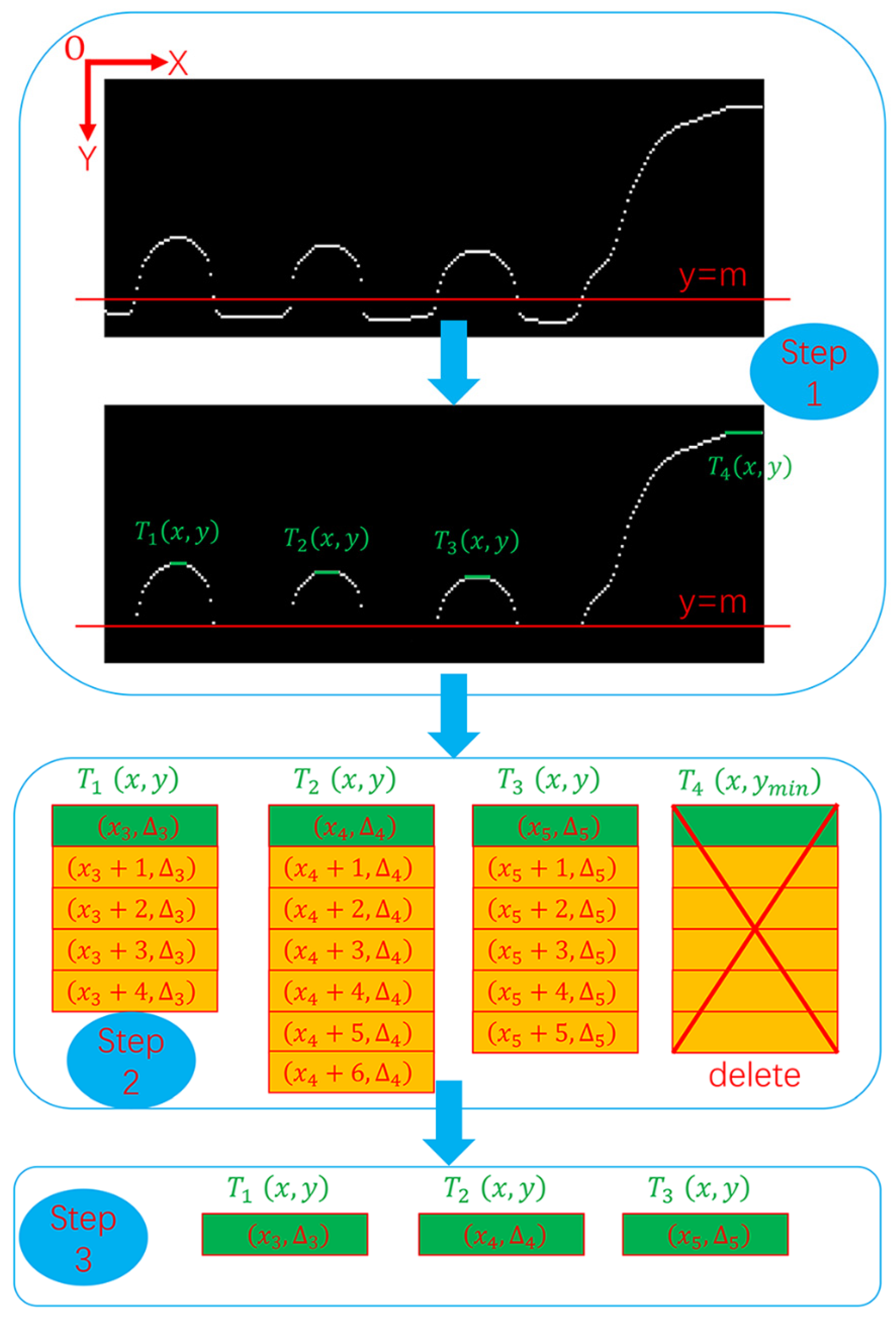
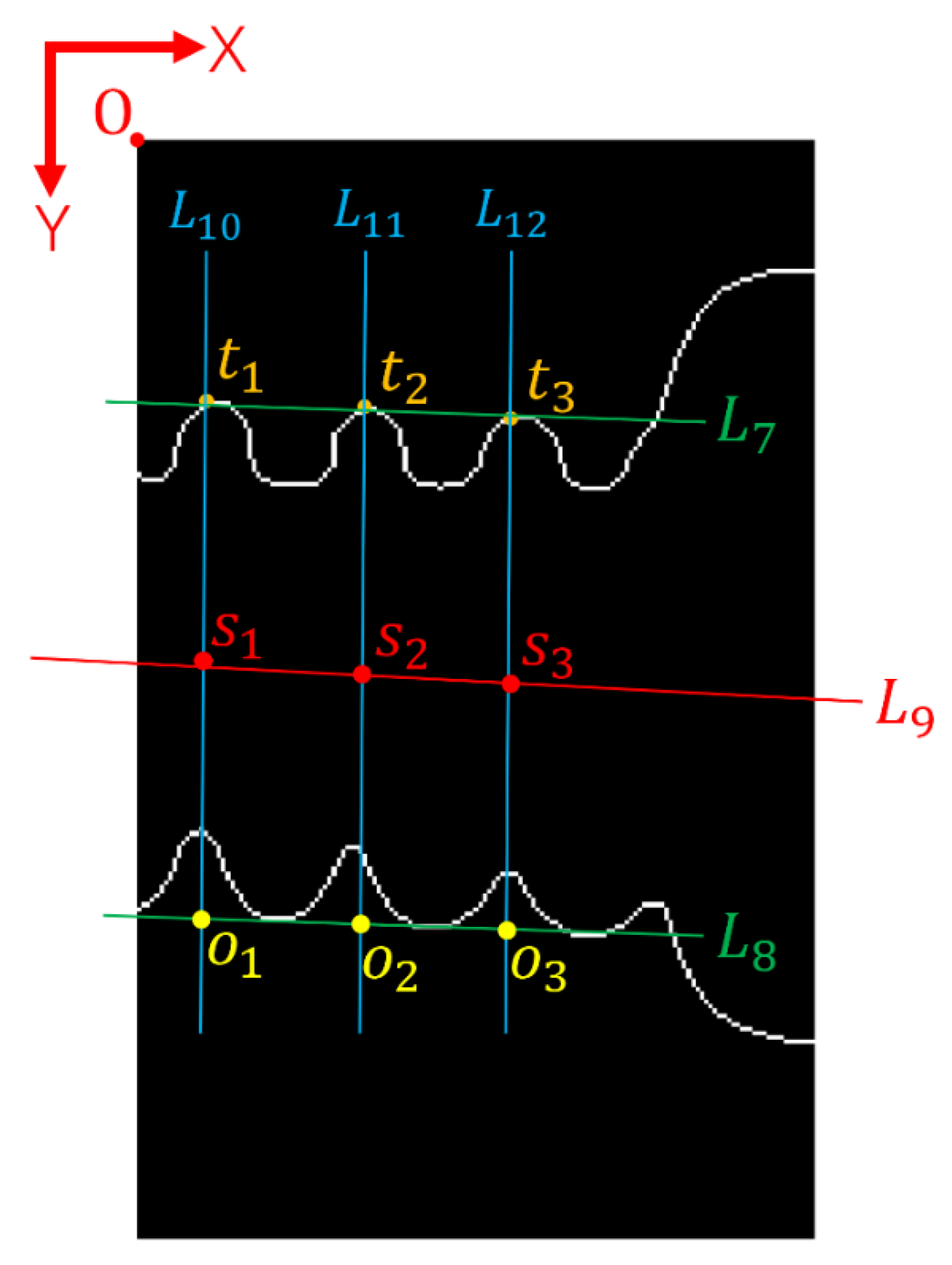
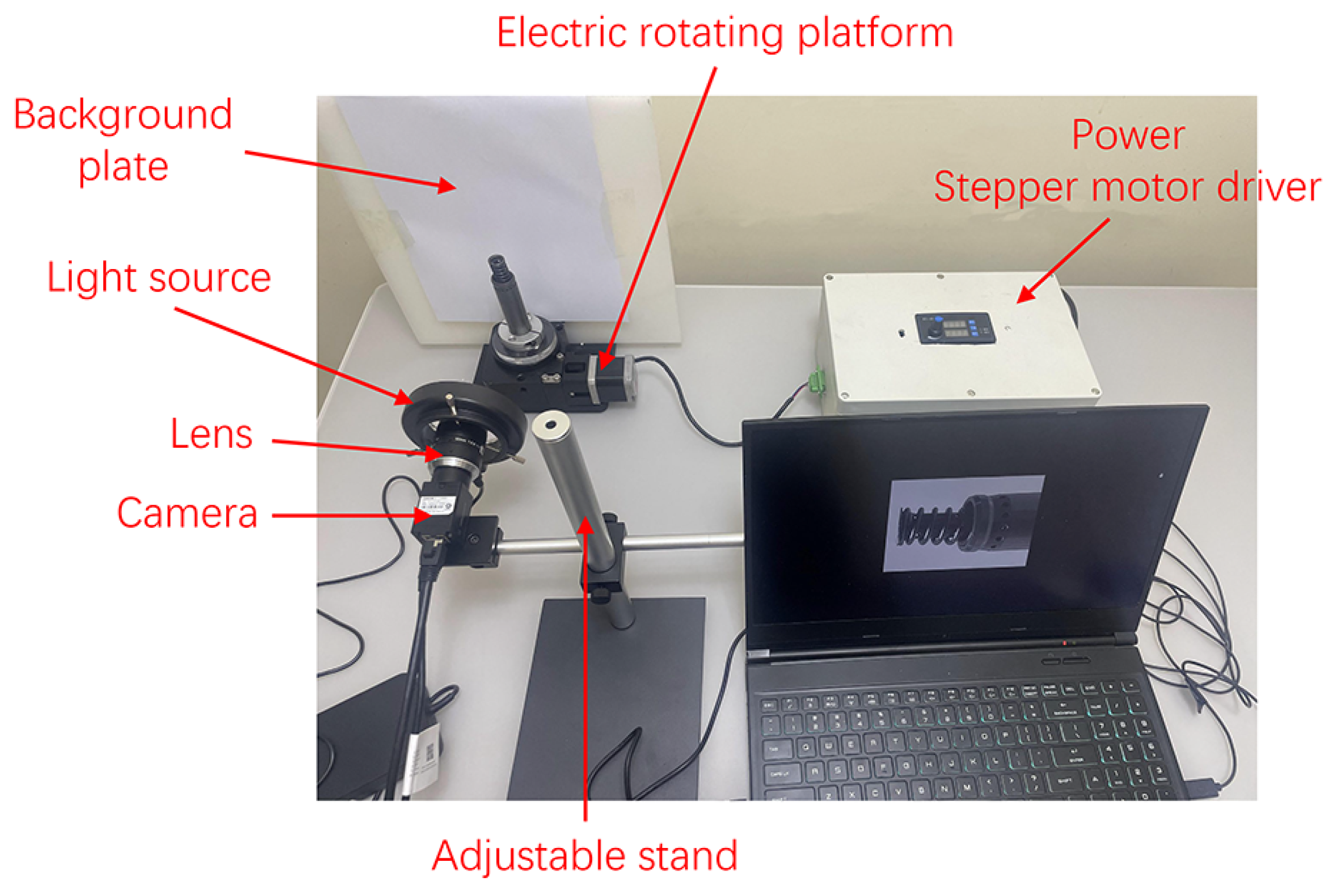
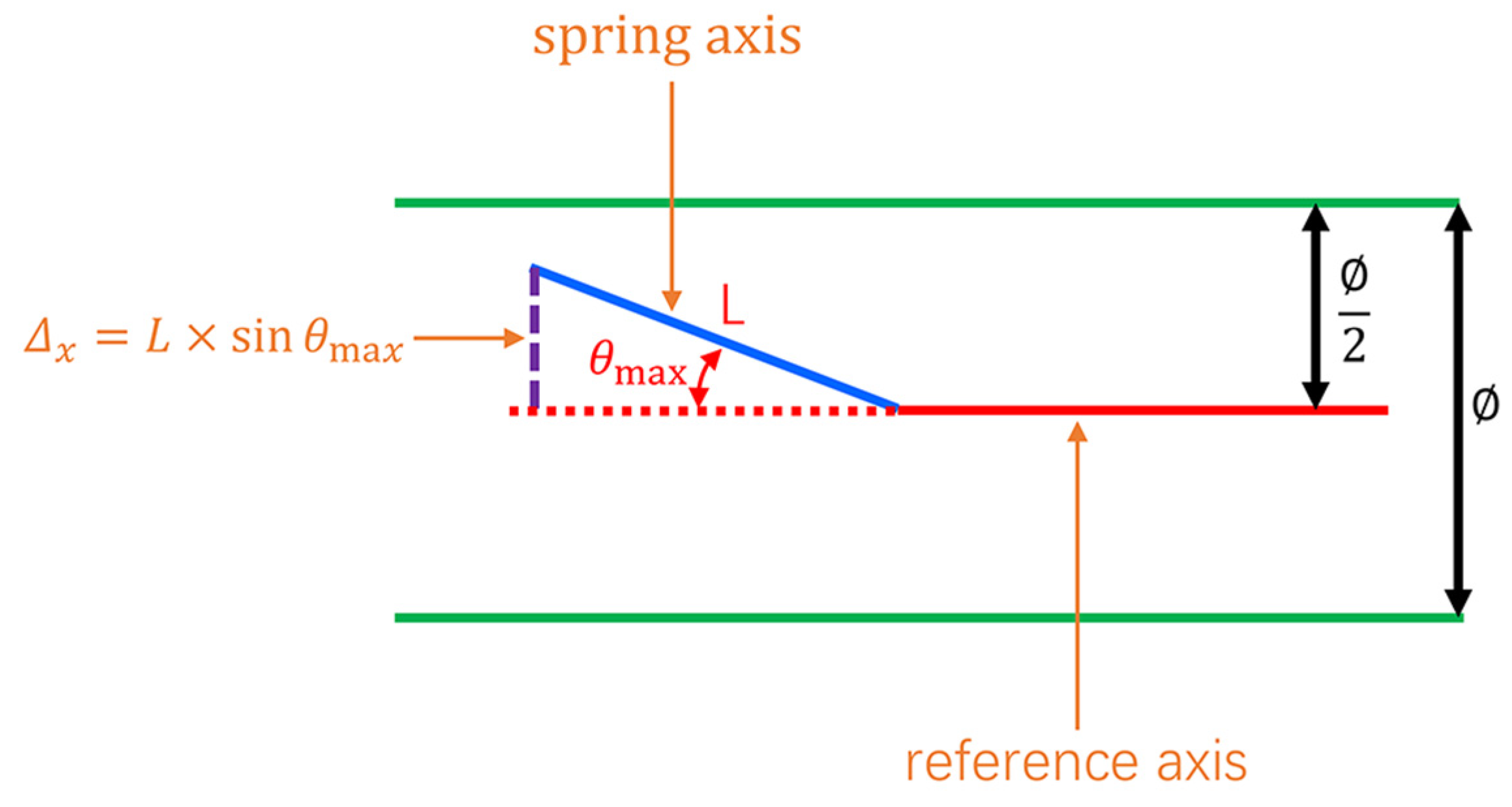
| Image Number | Angle (°) | Image Number | Angle (°) | Image Number | Angle (°) | Image Number | Angle (°) |
|---|---|---|---|---|---|---|---|
| 1 | 0.2665 | 11 | 0.5877 | 21 | 0.9111 | 31 | 0.8944 |
| 2 | 0.3155 | 12 | 0.5954 | 22 | 0.9470 | 32 | 0.8313 |
| 3 | 0.3551 | 13 | 0.6186 | 23 | 0.9827 | 33 | 0.7747 |
| 4 | 0.4052 | 14 | 0.6563 | 24 | 1.0071 | 34 | 0.6863 |
| 5 | 0.4265 | 15 | 0.6877 | 25 | 1.0254 | 35 | 0.5115 |
| 6 | 0.4655 | 16 | 0.7254 | 26 | 1.0204 | 36 | 0.4313 |
| 7 | 0.4751 | 17 | 0.7586 | 27 | 1.0004 | 37 | 0.3947 |
| 8 | 0.4952 | 18 | 0.7763 | 28 | 0.9827 | 38 | 0.3136 |
| 9 | 0.5177 | 19 | 0.8517 | 29 | 0.9570 | 39 | 0.2907 |
| 10 | 0.5377 | 20 | 0.8937 | 30 | 0.9344 | 40 | 0.2717 |
| Reference [4] | Reference [3] | Reference [7] | This Paper | |
|---|---|---|---|---|
| Data collection method | Laser displacement sensor | Laser scanner | Laser collimator | Industrial camera |
| Detection type | bevel gear and spline | Crankshaft journal | Large span small hole | Automotive brake piston components (modify parameters for measurement of other stepped shaft parts) |
| Detection method | The coaxiality error is calculated from the measured value of the laser displacement sensor. | The coaxiality error is calculated by using 3D point cloud data. | The coaxiality is detected via laser module | Geometric feature points are extracted based on image processing technology |
Disclaimer/Publisher’s Note: The statements, opinions and data contained in all publications are solely those of the individual author(s) and contributor(s) and not of MDPI and/or the editor(s). MDPI and/or the editor(s) disclaim responsibility for any injury to people or property resulting from any ideas, methods, instructions or products referred to in the content. |
© 2024 by the authors. Licensee MDPI, Basel, Switzerland. This article is an open access article distributed under the terms and conditions of the Creative Commons Attribution (CC BY) license (https://creativecommons.org/licenses/by/4.0/).
Share and Cite
Li, Q.; Ge, W.; Shi, H.; Zhao, W.; Zhang, S. Research on Coaxiality Measurement Method for Automobile Brake Piston Components Based on Machine Vision. Appl. Sci. 2024, 14, 2371. https://doi.org/10.3390/app14062371
Li Q, Ge W, Shi H, Zhao W, Zhang S. Research on Coaxiality Measurement Method for Automobile Brake Piston Components Based on Machine Vision. Applied Sciences. 2024; 14(6):2371. https://doi.org/10.3390/app14062371
Chicago/Turabian StyleLi, Qinghua, Weinan Ge, Hu Shi, Wanting Zhao, and Shihong Zhang. 2024. "Research on Coaxiality Measurement Method for Automobile Brake Piston Components Based on Machine Vision" Applied Sciences 14, no. 6: 2371. https://doi.org/10.3390/app14062371
APA StyleLi, Q., Ge, W., Shi, H., Zhao, W., & Zhang, S. (2024). Research on Coaxiality Measurement Method for Automobile Brake Piston Components Based on Machine Vision. Applied Sciences, 14(6), 2371. https://doi.org/10.3390/app14062371





